PinotFile: 11.25 June 26, 2018
|
100% Whole Cluster Pinot Noir: Upping the AnteThe fermentation of the entire grape cluster including the stem that attaches the berries to the vine, is commonly referred to as stem inclusion, bunch inclusion or whole cluster inclusion. De-stemming machinery is bypassed, leaving all the berries and attached stems intact. The Burgundians practiced 100% whole cluster inclusion for centuries as historically they had no de-stemmers. With the introduction of mechanical de-stemmers about 60 years ago, whole cluster fermentation was largely abandoned worldwide, or limited to fermentation of a small percentage of clusters. Today, a higher percentage of whole cluster fermentation is more fashionable, and there is renewed interest both in Burgundy and stateside. That said, it’s use in Pinot Noir vinification remains controversial, a wild card in the winemaker’s tool box that is a bit of a gamble. It is high stakes, stressful winemaking that can thoroughly enhance or dreadfully detract from a finished wine. There are no scientific, well-controlled studies that have shown reproducible effects, only considerable anecdotal opinions. Professor Roger Boulton of UC Davis has pointed out that the contributions of whole cluster fermentation are at least due to two aspects: the intact berries of the whole cluster and the extraction and adsorption properties of the stems. The first is known as carbonic maceration where the berry cells undergo a biochemical modification internally (intra-berry anaerobic fermentation) producing a lifted fresh fruit-candy character. The inclusion of stems are the best vehicle for ensuring a higher percentage of whole berries. The second aspect is less clearly understood, but it is well known that the inclusion of stems can potentially give the wine a green or herbaceous character, presumably from the release of organic methoxypyrazine compounds from stems.
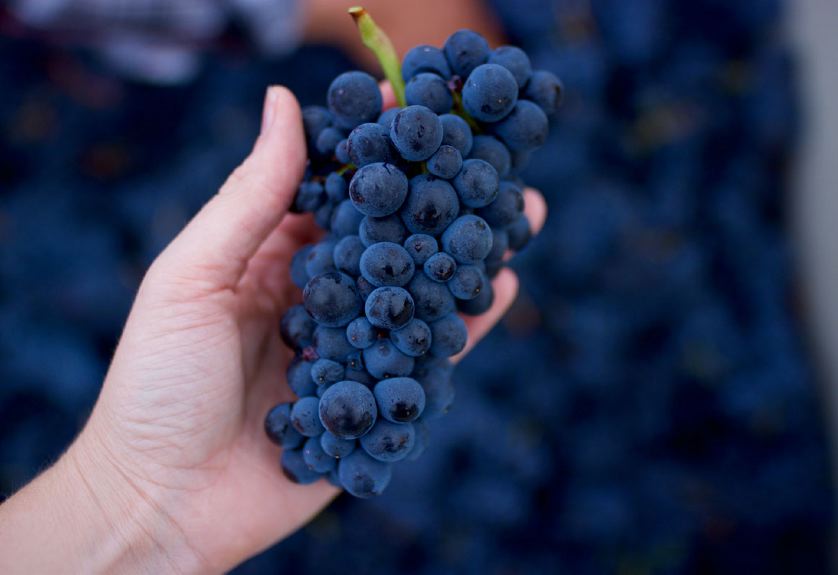 Those winemakers who employ or at least experiment with whole cluster fermentation point out many perceived advantages:
(1) Added perfume of spice, pine sap, forest floor, black tea, rose petal, burnt tobacco. Winemaker Jeff Fink says, “The aromatics can be thrilling and literally spine-tingling. There can be a purity, depth and freshness to the bouquet that almost defies description.” Aromatics in Pinot Noir is the most challenging component to capture and whole cluster fermentation can potentially meet this challenge. (2) Changes in tannin structure and added tannins. Kevin Harvey, owner of Rhys Vineyards, remarks, “Speaking organoleptically…. the stems contribute some silky smooth mid-palate tannins while preventing the harsh seed tannin from being released since the grape remains encapsulated longer.” Also, the added tannins may contribute to the improved longevity of the wine. (3) Slower fermentation by dissipating heat. Winemaker Jim Schultze of Windy Oaks Winery & Vineyards notes, “Fermentation temperatures are lower with 100% whole cluster fermentation, no doubt extending the fermentation, but also resulting in a different flavor profile.” (4) More carbonic maceration (whole intra-berry fermentation) contributing to cooler and longer fermentations as well as markedly affecting the aroma and flavor profile. (5) Stability of the wine improved. For example, the stability of the wine’s color is increased because pigment is bound with tannin. (6) Lower final ABV. This is thought to be due in part to the stems releasing water during fermentation and pressing. This effect has never been quantified. (7) Added freshness to older Pinot Noir wines. Winemaker Ted Lemon told me, “A Pinot Noir that is ten years old and has a percentage of whole cluster will be more aromatically complex than the same wine that is 100% de-stemmed. (8) Added element of intrigue, uniqueness and evocative character. Winemaker Jeff Fink says, “Clearly, stems rock!” Winemaker Dave Keatley decried, “Whole cluster wines, when they click are luscious, profound and cerebral.”
Those winemakers who decline to employ whole cluster fermentation point out several disadvantages:
(1) Potential for green, herbaceous and vegetative aromas and flavors from stem methoxypyrazines and other compounds, variously described as green beans, snap peas, broccoli, tomato leaves, green bell pepper, green tobacco, unlit cigar tobacco. (2) Potential for chalky astringency, bitterness and harsh tannins. That said, in general, most winemakers report that the increase in pH and presence of partial carbonic maceration tends to produce softer tannins in some cases. (3) Less intense color. Not universally observed and some winemakers note no reduction in pigmentation and even darker wines following whole cluster fermentation. (4) Increased potassium in the ferment and resulting increased pH. This may require acidification of the wine and loss of natural winemaking protocol. (5) Whole cluster fermentation can dominate the vineyard character. That said, others would argue that there is actually more expression of site (terroir). (6) The success of whole cluster fermentation is dependent on a multitude of factors including region, vineyard site (not all vineyards can be successfully fermented with 100% whole cluster), clones (some clones seem better suited to whole cluster fermentation such as Swan but the science is not known), and vintage. It is often the winemaker’s intuition that determines whether stems from a particular vineyard will impact the wine positively or negatively. (7) New World palates are fruit-centric and the savory elements whole cluster fermentation brings to Pinot Noir may not find widespread commercial appreciation or appeal. (8) The whole cluster fermentation process is more labor intensive and requires more attention than a de-stemmed wine. Pneumatic punch down devices and pump-overs cannot be employed as they can release more astringency into the ferment. (9) The winemaker’s imprint and whole cluster character can be a dominating feature of the wine.
The controversy over the use of whole clusters in fermentation is centered on stem lignification. The view of many winemakers has been that the stems have to be mature, woody and brown (lignified) at harvest for whole cluster fermentation to be advantageous. The thought has been that if the stems are not lignified, they can add more undesirable harsh green tannins and herbaceous characters. Some have challenged this line of reasoning by pointing out that lignification is the hardening and firming up of cells in the stem, not a turning brown of the stem. That is, the stems may still be bright green, even when they are lignified appropriately. Others would claim the critical factor is the amount of sap in the stem and not its degree of lignification. Winemaker Carlo Mondavi of RAEN Winery has said, “Waiting for full brown stems is a major mistake in my opinion….if you wait that long you are looking at harvesting well north of 25º Brix. This can yield a wine of incredible bitterness and a pH that is not amenable to fermentation as well as a wine that is unstable naturally. I make our cuts where the rachis (stem) meets the shoot, an area that is brown and lignified. We make our harvesting cuts right in the middle of the browning area to minimize sap flowing into the juice.” Vineyards with well-drained rocky soils and lacking in late season rainfall tend to perform better with whole cluster fermentation since there is less tendency for the vine to push sap and water into the cluster. There are currently three basic camps domestically with regard to whole cluster fermentation. By far the largest group of winemakers completely de-stem prior to fermentation. The second largest group of winemakers like to add some percentage of whole clusters, say 10-30% up to 50% depending on numerous factors. Some in this group produce a limited bottling of 100% whole cluster Pinot Noir. The third and smallest number of winemakers are committed to 100% whole cluster fermentation if feasible in all their wines. Whole cluster has become a badge of courage and accomplishment and many winemakers include the words “whole cluster” on their appropriate wines. Where do I stand on whole cluster? I seem to prefer Pinot Noir wines with at least some whole cluster inclusion and a majority of my favorite domestic wines over the past forty years have been ones with at least some whole cluster inclusion.
Sizable Tasting of 100% Whole Cluster California & Oregon Pinot Noir
Kramer Vineyards 2014 Pinot Noir Whole Cluster TrialKim Kramer was kind to send me the wines from Kramer Vineyards Whole Cluster Trial. The purpose of the trial was to see what percentage of whole cluster fermentation was most suitable for the winery’s estate vineyard. All grapes were sourced from the main block of the estate vineyard Pinot Noir and harvested September 20 & 21, 2014. The vines are both own rooted and grafted planted between 1985 and 1995, consisting of Wädenswil, Pommard, and Gamay Beaujolais clones. Five tons of grapes were harvested by hand and separated into five vats with different quantities of whole clusters ranging from 0% to 100%. All lots underwent a 4 to 7-day cold soak and inoculation with RB2 yeast. After fermentation began, the vats were pumped over and punched down twice daily and pressed to dryness. After pressing, the wines were aged in older French oak barrels until bottling in the winter of 2016. The two charts below show fermentation temperatures for each wine and sugar depletion rate for each wine. The more whole cluster inclusion, the lower the fermentation temperature and the slower the fermentation.
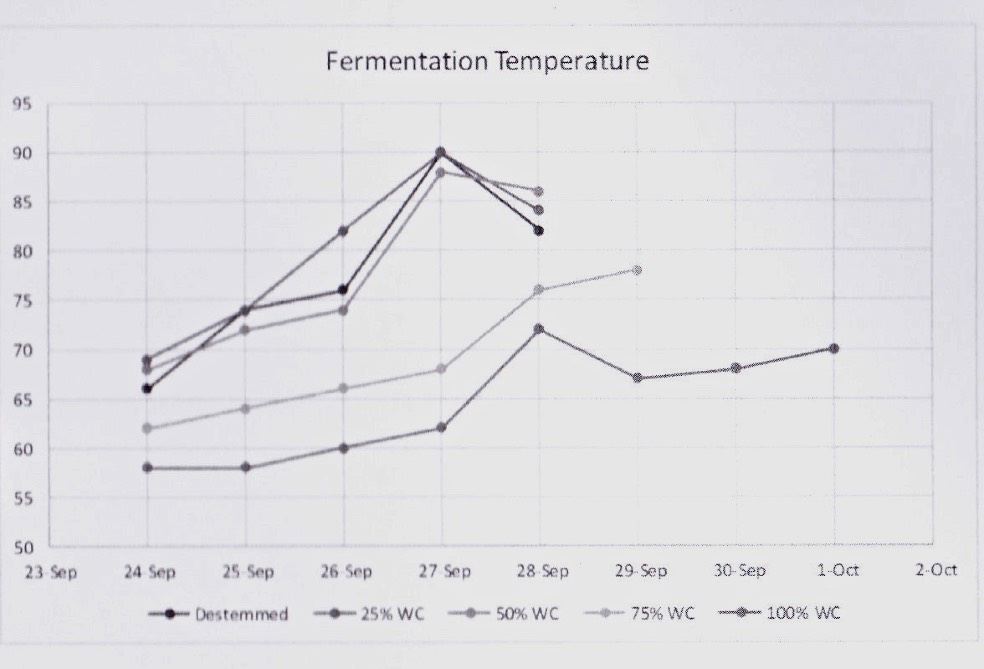
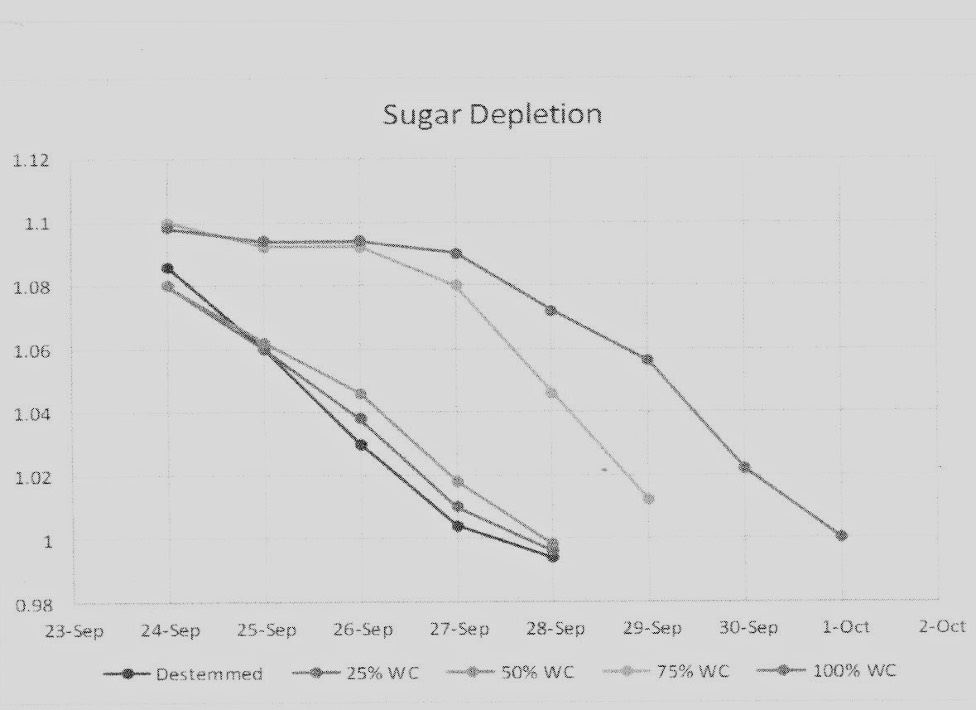
 CONTROL: 2014 Pinot Noir Estate. Harvest Brix 21.4º. 100% de-stemmed, aged 10 months in French oak barrels, 25% new. Final chemistry: 13.0% alc., pH 3.46, TA 0.67. Wine #1: 0% whole cluster. 12.4% alc., pH 3.51, TA 0.64. Shy, but pleasant aromas of berry fruits and savory herbs. Primarily fruity (cherry and berry) with only slight savory notes and tannins. Wine #2: 25% whole cluster. 12.4% alc., pH 3.43, TA 0.74, pressed October 1, 2014. The nose is similar to the 0% whole cluster wine. Noticeably more intense fruit expression and more tannin. Wine #3: 50% whole cluster. 12.6% alc., pH 3.80, TA 0.68, pressed October 4, 2014. Very appealing aromas of spice and floral perfume. Very good intensity of red and blue fruits with slightly more tannin and more finishing power and length. Wine #4: 75% whole cluster. 12.9% alc., pH 3.73, TA 0.50, pressed October 5, 2014. The nose is quite grounded in earth and floral perfume. Brighter fruit, some earthiness, more tannin and more finishing length. Wine #5: 100% whole cluster. 13.2% alc., pH 3.61, TA 0.59, pressed October 13, 2014. Lovely aromas of spice and rose petal. Fruit brightness seems less and the wine is slightly vegetal. There is noticeable tannins and a very slight astringency. My conclusion was that somewhere between 50% and 75% whole cluster seemed optimum for this wine in terms of aromas, fruit brightness, structure and finish, four years after the vintage and two-and-a-half years after bottling. 25% whole cluster added more fruit intensity and tannin but not more desirability. The 100% whole cluster wine may also turn out to be quite good if given more time in bottle. Winemaker Jamie Kutch of Kutch Wines is a strong proponent of whole cluster fermentation and in recent vintages has committed to vinifying all his wines with 100% whole cluster fermentation. He told me the following which adds to the discussion. “When one makes a Pinot Noir at 12.1% alcohol (which Jamie often does), the wine can often taste light in body….to counterbalance and add power, length and body, I let high levels of stem inclusion do the work. Stems take a round wine and broaden its shoulders, building it up. I have done the experiment multiple times in multiple vintages and with multiple vineyards and always observed the same results. It goes like this: 5 experiments: 100% de-stem vs 25% whole cluster vs 50% whole cluster vs 75% whole cluster vs 100% whole cluster. All wines were from the same vintage, same vineyard same pick date, same clone, same exposure, fermented identically, and elevage in the same aged barrels from the same cooper. Tasting indicates that complexity goes up and up and up from the de-stemmed wine to the 100% whole cluster wine. The de-stemmed wine just isn’t close to the whole cluster wine in terms of complexity. Those experiments have led me to avoid making de-stemmed wines.” That said, Jamie qualifies his comments by saying, “There is no wrong or right in wine and everything I have said here is only my opinion. My journey of making wine for 11 years and 20 years of hardcore wine exploration and drinking has taken me to this point.”
100% Whole Cluster Pinot Noir Tasting
Flight #1: California 100% Whole Cluster Pinot Noir2014 Domaine De La Coté la Coté Sta. Rita Hills Pinot Noir 12.5% alc., 820 cases, $90. 0.5 acres planted in 2007 to California heritage selections, high vine density. Ambient yeast fermentation. Winemaker Sasha Moorman. Very light ruby red color in the glass. Aromas of spice and burnt tobacco. Lighter in weight with red cherry, spice and tobacco flavors, finishing with great intensity. Bright acidity. Winemakers thought too much oak overlay in this wine, detracting from the whole cluster inclusion. 2015 Big Basin Vineyards Alfaro Family Vineyard Santa Cruz Mountains Pinot Noir 13.5% alc., 100 cases, $60. 16-year-old vines planted at 588-730 feet in sandy gravelly loam in Corralitos. Clones 115, 667 and 777. Aged 15 months in French oak barrels, bottled unfined and unfiltered. Winemaker Bradley Brown. Moderate garnet color in the glass. Aromas of darker fruits and leaf. Nicely composed with mid weight flavors of darker fruits along with a savory vegetal thread that is more complimentary than intrusive. 2015 Whitcraft Winery Pence Ranch Pommard Clone Sta. Rita Hills Pinot Noir 12.4% alc., pH 3.68, $62. Eastern Sta. Rita Hills location with diverse, well-drained soils. Pommard clone. Williams Selyem yeast, minimal sulfur, bottled unfined and unfiltered. Winemaker Drake Whitcraft. Moderately light garnet color in the glass. Aromas of spice, cherry, cologne and clay. Light to mid weight flavors of cherry fruit with a vegetal thread that compliments. Bright acidity. 2015 Carr Vineyards & Winery Hillside Whole Cluster The Yard Vineyard Sta. Rita Hills Pinot Noir 14.0% alc., 50 cases, $70. Vineyard planted in 1998 in sandy loam soil with significant limestone content. Clone 667. Aged 18 months in French oak barrels, 15% new. Winemaker Ryan Carr. Moderately light garnet color in the glass. Aromas of very ripe fruit including raisin and prune. An array of purple berry fruit flavors with noticeable tannins and some finishing length. The group felt the marked ripeness of the fruit obscured any whole cluster inclusion character. 2016 HIBO Alder Springs Vineyard Mendocino County Pinot Noir 14.2% alc., 75 cases, $45. Vineyard planting begn in 1993 by Stu Bewley. Clone 459. Aged 10 months in French oak barrels. Winemaker Jason Driscoll. Dark garnet color in the glass. Aromas of well-ripened fruit with a touch of oak. More appealing on the palate with an array of purple and black berry fruits and muscular tannins. Some astringency on the finish. 2016 Kutch McDougall Ranch Sonoma Coast Pinot Noir 12.0% alc., $59. Vineyard is 3.5 miles from Pacific Ocean at 935-1,030 feet elevation, 1.7 miles north of Hirsch Vineyards. Soils are Graywacke and sandstone. Clones 114, 115. Native primary and malolactic fermentations. Aged 12 months in neutral French oak barrels. Moderately light garnet color in the glass. Lovely aromas of rose petal, spice and cologne. Bright cherry and raspberry flavors with an exotic spice accent. Modest tannins, bright acidity and welcome finishing length. I felt this wine showed the best expression of whole cluster inclusion. The tannins were reigned in and the wine was very approachable.
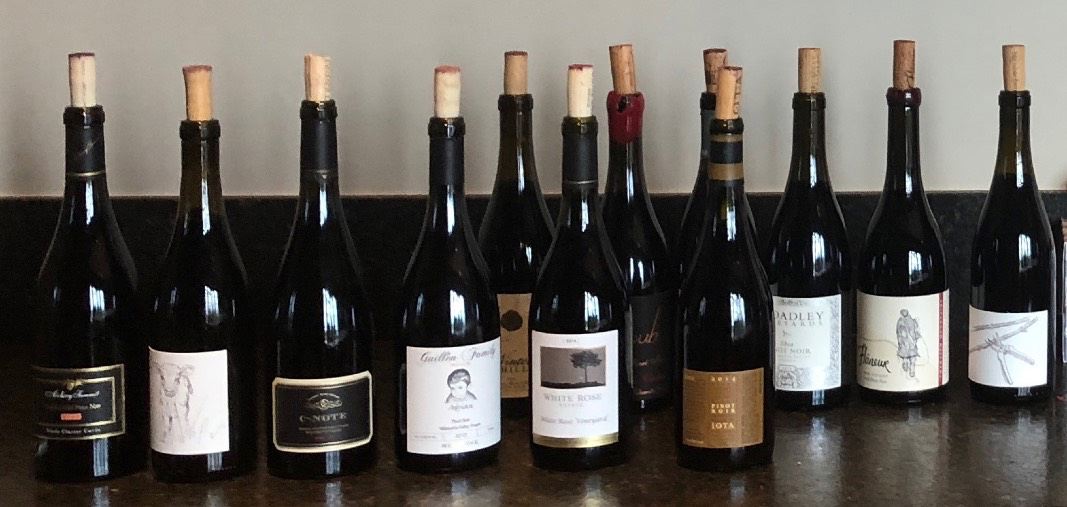
Flight #2: Oregon 100% Whole Cluster Pinot Noir2012 Archery Summit Whole Cluster Cuvée Willamette Valley Pinot Noir 13.5% alc., $85. Estate fruit. Native yeast fermentation. Winemaker Christopher Mazepink. Moderately light garnet color in the glass. Nicely perfumed with aromas of spice, eucalyptus and dark cherry. Well-balanced, with a black cherry core of fruit. Sleek tannins and a slight herbaceous thread. Wouldn’t guess this was 100% whole cluster (not confirmed). 2012 Big Table Farm Resonance Vineyard Yamhill-Carlton Willamette Valley Pinot Noir 14.7% alc., 326 cases, $48. Last vintage as vineyard was sold to Louis Jadot in 2013. Winemaker Brian Marcy. Moderate garnet color in the glass. Soaring aromas of spice, dark fruits and tobacco. Luscious and generous on the palate, with integrated tannins and an amazingly long finish. 2013 Tendril Wine Cellars C-Note Yamhill-Carlton Willamette Valley Pinot Noir 14.0% alc., 102 cases, $100. Aged 18 months in French oak barrels. Winemaker Tony Rynders. Moderate garnet color in the glass. Deep cherry aromas with a hint of oak. Robust black cherry fruit flavor with a hint of tobacco. Minimal oak input with a notably long finish. Whole cluster well integrated in this special wine. 2013 Guillén Family Wines Adrian Reserve Willamette Valley Pinot Noir 12.6% alc., 75 cases, $40. Clone 667 planted in 2005 at Vista Hills Vineyard, Block F. Natural yeast fermentation. Aged on the lees 11 months in 100% new, light toast French oak barrels. Winemaker Jesus Guillén. Moderately light garnet color in the glass. Inviting aromas of red cherry, spice and burnt tobacco. Light to medium weight in style, with plenty of spiced red cherry fruit to satisfy. The tannins are very modest and a bit of oak adds pleasure. Whole cluster inclusion very evident in this wine. 2014 White Rose Estate White Rose Vineyard Dundee Hills Willamette Valley Pinot Noir Corked. 2015 Guillén Family Wines Damian Winemaker’s Cuvée Willamette Valley Pinot Noir 13.8% alc., 73 cases. A barrel selection. Pommard and Dijon 667. Aged 12 months on the lees in 100% new French oak barrels. Filtered at bottling. Winemaker Jesus Guillén. Light ruby red color in the glass. Aroma of dark raspberry and cherry. Soft tannins, with delightful flavors of cherry and berry, nicely spiced. Noticeable whole cluster inclusion. 2014 IOTA Cellars Pelos Sandberg Vineyard Whole Cluster Eola-Amity Hills Willamette Valley Pinot Noir 14.0% alc., 94 cases, $44. 11.5 acre non-irrigated vineyard. Clones 777, 667, Wädenswil (25% each). Aged 10 months in 25% new French oak barrels. Winemakers Don and Johanna Sandberg. Moderately dark garnet color in the glass. Aromas of toast and tobacco with little fruit. Imposing oak toast and guiacol/smoke flavors overlay the black cherry fruit core. Whole cluster inclusion largely hidden.
Flight #3: Oregon 100% Whole Cluster Pinot Noir2015 Winter’s Hill Vineyard Block 10 Whole Cluster Dundee Hills Willamette Valley Pinot Noir 14.2% alc., 98 cases, $49. 35-acre vineyard, 20 acres are original planted in 1990. 525-750 feet elevation, Jory soil. Pommard clone. Winemaker Delphine Gladhart. Light ruby red color in the glass. Predominantly savory on the nose with shy cherry fruit aromas. Explosion of cherry fruit on the palate with an incredibly long finish. Whole cluster beautifully integrated. 2015 Ayoub Estate Whole Cluster Dundee Hills Willamette Valley Pinot Noir 13.3% alc., pH 3.60, 120 cases, $75. Sourced from the 4-acre estate vineyard. Pommard and Dijon clones. 5-day cold soak, mostly pump overs, 28 days on skins, aged 11 months in French oak barrels, 25% new. Winemakers are Mo Ayoub and Robert Brittan. Light ruby red color in the glass. Inviting marriage of savory and red fruit aromas. Very seductive on the palate with fresh red fruit flavors, balanced tannins and a gracious finish. Would not have guessed this wine was 100% whole cluster other than its freshness. 2015 Evening Land Anden Seven Springs Vineyard Eola-Amity Hills Willamette Valley Pinot Noir 12.5% alc., $100. Pommard and Wädenswil clones from original plantings in 1984 on own roots. Aged ;in 100% new Ermitage oak barrels. Unfiltered. Winemaker Sasha Moorman. Lightest color in this flight. Lovely perfume of rose petal, red cherry and spice. Lightly weighted and soft in the mouth, but with imposing red cherry and berry flavor, supportive tannins, some oak overlay, and an extraordinarily finish. 2016 Broadley Vineyards Shea Vineyard Yamhill-Carlton Willamette Valley Pinot Noir 13.8% alc., 300 cases, $56. Clones 777 and Wädenswil. Native yeast fermentation in open-top French oak fermenters. Aged 12 months in French oak barrels, 30% new. Winemaker Morgan Broadley. Moderate garnet color in the glass. Engaging aromas of darker red fruits and spice. Really spectacular with an array of fresh dark fruit flavors, some supportive tannins and fully satisfying finish. Has the balance to age. 2016 Flâneur Bon Vivant Chehalem Mountains Willamette Valley Pinot Noir 14.2% alc., pH 3.79, TA 0.55, 122 cases, $50. 75% Belle Promenade Vineyard and 25% Flâneur Vineyard. Native yeast fermentation, aged 12 months in French oak barrels, 25% new. Winemaker Grant Coulter. Moderately dark garnet color in the glass. Slightly green aromas with added notes of tobacco. Fruit is on the riper side but the wine has an air of sophistication with invigorating tannins but no astringency. 2016 Big Table Farm Pelos-Sandberg Vineyard Eola-Amity Hills Willamette Valley Pinot Noir. 13.9% alc., 285 cases, $62. 11.5-acre non-irrigated vineyard. Pommard, 777 and Wädenswil clones. Unfined and unfiltered. Winemaker Brian Marcy. Moderately light garnet color in the glass. Energized aromas of rose petal, spice and a hint of smoke. Highly enjoyable, with a solid core of black cherry fruit and a smoky thread typical of this vineyard. Modest tannins and some length on the finish.
One more wine inadvertently left out of the tasting: 2014 Analemma Atavus Columbia Gorge Oregon Pino Noir 13.8% alc., 90 cases, $44. Vineyard has been dry-farmed since its inception in the late 1960s. 1700 feet elevation. 100% Mariafeld clone, 100% whole cluster fermentation. Moderate garnet color in the glass. Revealing aromas of black cherry, wilted rose, spice and tree sap. Middleweight in style, with a hearty core of dark cherry and dark berry fruits with an interesting spice accent. Well-structured, with fine-grain tannins leading to mild astringency on the finish. Veers from the ordinary in a good way.
Impressions and ConclusionsThe color of the wines varied from light to moderately dark so this is a non-issue. None of the wines had a significant herbaceous component. When present, it was often a pleasant savory addition and never detracted from the wine. Whole cluster inclusion seems to work best when grapes are picked earlier and there is minimal to modest new oak barrel treatment. Very ripe fruit and a high percentage of new oak obscure the subtleties of whole cluster fermentation. It would seem that high fruit ripeness and therefore more lignification of stems is not a worthwhile goal. Whole cluster aromatics and flavors were not overwhelming in most wines and added character and textural interest in many cases. Increased tannins were evident in several wines, but they were texturally soft and appealing rather than grainy or astringent and would be expected to add longevity to the wines. Although 100% whole cluster inclusion can increase acidity, none of the wines showed skewed acidity in the finished wine.
Seeking Out Domestic Whole Cluster Pinot NoirCalifornia wineries that are committed to significant whole cluster fermentation of Pinot Noir: Big Basin Vineyards, Calera Wine Company, Domaine de la Côte, Kutch Wines, RAEN Winery and Whitcraft Winery. Oregon wineries that are committed to significant whole cluster fermentation of Pinot Noir: Big Table Farm, Broadley Vineyards, Cristom Vineyards, Evening Land Vineyards, Guillén Family Wines, Hundred Suns Wines and White Rose Estate.
Benovia Pinot Noir Full of Sunshine in 2016 VintageWinemaker Mike Sullivan had no complaints about the exceptional 2016 vintage. The growing season was relatively even after abundant winter rains helped to alleviate the effects of four years of drought. Moderate but warm daytime temperatures and cooler nights were welcome in the Russian River Valley where harvest was a week or so later than in 2015, allowing the vines to soak up every ray of sunshine. The results are Pinot Noir wines with exuberant sap, yet the proper balance of acids and tannins to allow both satisfying early consumption and age ability. I have sampled Benovia Pinot Noir wines from every vintage since their first commercial release in 2006 and I must say that these wines are truly unique because of their extraordinary fruit concentration yet easy going nature. They are like a big teddy bear that is easy to cozy up to. I can guarantee you will love the entire lineup! With yields somewhat in excess of the 2015 vintage, there is more wine available, but don’t put off your acquisition of these delicious, sunshine-infused wines. Benovia Winery owners Joe Anderson and Mike Sullivan are beaming over the 2016 vintage wines:
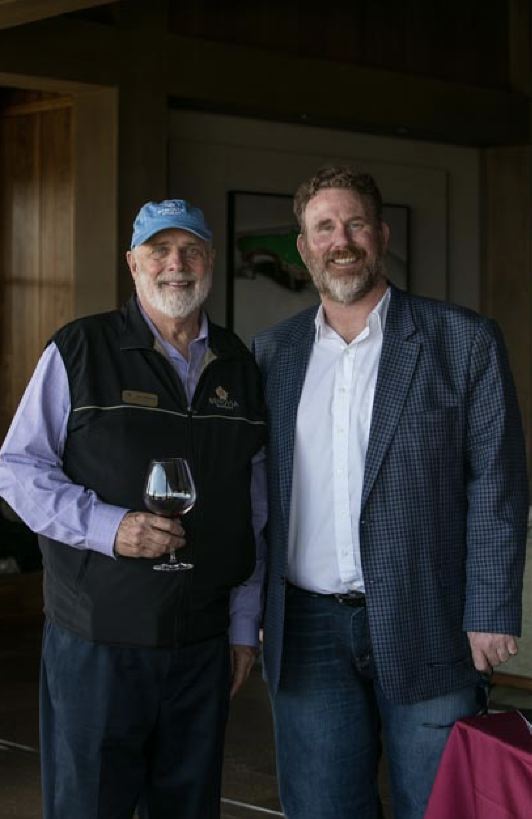 With regard to Pinot Noir vinification, de-stemming is the rule although some bottlings in some vintages may have up to 25% -35% whole cluster inclusion. Indigenous yeast fermentations follow a cold soak and aging occurs in French oak barrels for 16-17 months in a moderate amount of new oak (approximately 30%-40%). The winery produces wines primarily from estate vineyards located in Sonoma County: Cohn Estate, Martaella Estate, and Tilton Hill Estate. Grower vineyards include Three Sisters in Fort Ross-Seaview, Four Brothers on Sonoma Mountain, and Zio Tony Ranch in the Russian River Valley. These 2016 wines are still young and it is to their credit that they are so appealing now. You can drink them upon release but are very amenable to ageing and it would be a shame not to stash a few bottles away for 3-5 years. The 2016 Russian River Valley Pinot Noir and 2016 La Pommeraie Chardonnay have been released. The rest of the 2016 wines will be released in the fall 2018.
2016 Benovia Russian River Valley Pinot Noir 14.1% alc., pH 3.59, TA 0.62, 1,087 cases, $42. Released April 2018. Sourced from Martaella Estate, Cohn Estate, Tilton Hill Estate, and Zio Tony Ranch vineyards. A blend of Calera, Swan, Pommard, Mt. Eden, Chalone, and Dijon 777 and 943 clones. 8-day cold soak, 100% de-stemmed into open-top fermenters for native yeast fermentation over 2 weeks. . Aged 16 months in French oak barrels, 37% new. · Dark garnet color in the glass. Engaging aromas of fresh blueberry, pomegranate and blackberry with a hint of toasty oak. Plush on the palate in a well-endowed style featuring blue and black berry fruits. Remarkable intensity in the mouth and on the finish. Sumptuous oak acts in harmony. Very welcoming now. An exceptionally good AVA wine following in the footsteps of the equally fine 2015 version. The wine does not have the concentration, intensity and finish of the other 2016 Benovia Pinot Noirs, but it can stand on its own as a special wine that will find widespread appeal. Score: 91
2016 Benovia Martaella Estate Vineyard Russian River Valley Pinot Noir 14.5% alc., $60. 42 acres of Pinot Noir and Chardonnay located in the Laguna de Santa Rosa. Combined volcanic and sedimentary soils (Huichica loam). 14 different clones planted. · Dark garnet color in the glass. The nose opens beautifully over time in the glass, revealing a perfume of black raspberry, blackberry, spice and wine cave. Attacking black cherry and black raspberry fruits with a spice accent in a mid weight style framed by a whisper of oak. A gentle, comforting wine that is creamy on the palate, with enjoyable length in the mouth and on the finish. The aromatics became really seductive when the wine was tasted a day later from a previously opened and re-corked bottle. Score: 93-94
2016 Benovia Bella Una Russian River Valley Pinot Noir 14.2% alc., $80. A winemaker selection of barrels that are the best expression of the vintage. · Aromas of interest evolve over time including boysenberry, blackberry and sweet oak. Mid weight plus in style with a core of well-ripened purple and black berry fruits. Well-structured for aging with a remarkably long finish filled with boysenberry fruit. The wine is reclusive upon opening but surfaces over time in the glass and is much more expressive when tasted the following day from a previously opened and re-corked bottle. The potential is obvious, but this special wine needs coaxing through decanting, or preferably, a few years in the cellar. The most backward wine in the lineup. Score: 93-94
2016 Benovia La Pommeraie Russian River Valley Pinot Noir 14.5% alc., $60. Sourced from the Zio Tony Ranch Vineyard that is located along the Laguna Ridge at the edge of the Green Valley of Russian River Valley AVA. The vineyard is farmed in conjunction with the Martinelli family. High density planting of 2,420 vines per acre, including clones 777 and “828.” The site was once an apple orchard so to pay homage to the history of the site the wine is named “La Pommeraie,” French for apple orchard. · Dark garnet color in the glass. The nose is flat-out terrific when allowed time and sampled a day ofter bottle opening. The perfume of blackberry, cassis and spice will bring you to your knees. A very polished wine in a mid weight plus style featuring waves of purple berry, blackberry, and plum fruits, accompanied by the right touch of spice and vanilla. There is very good structure, but the tannins are like suede. The long, succulent finish will bring you to your knees if the nose hasn't already. Score: 94-95
2016 Benovia Cohn Vineyard Sonoma County Pinot Noir 14.1% alc., $75. Vineyard originally planted in 1970 to a massale selection, likely Martini 13 and Pommard. This vineyard outdates most other plantings in the Russian River Valley by 20+ years. Farmed organically, yields are typically just over 1 ton-per-acre. This bottling is the outlier in the lineup for it offers much less fruit sap, but still is captivating in its own way. Aromas of cherry and sandalwood lead to a mid weight core of black raspberry and black cherry fruits dusted with oak. Even a hint of root beer shows up. Modest tannins and juicy acidity, soft and caressing in the mouth. Less concentrated fruit here, but more nuance, interest and charm. Score: 93-94
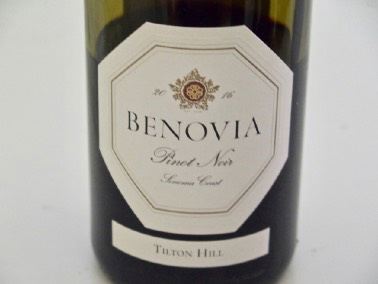 2016 Benovia Tilton Hill Vineyard Sonoma Coast Pinot Noir 14.1% alc., $60. A 12-acre vineyard three ridges inland from the Pacific Ocean. This cool site pushes the boundaries of cool-climate viticulture, with temperatures rarely reach 75 degrees Fahrenheit in the summer. Goldridge sandy loam soil. Dijon and heirloom clones. · Very dark garnet color in the glass. Searching for adequate descriptives, I think of this wine as freakish, profound and flat out ridiculous. I have rarely tasted such concentrated fruit in a Pinot Noir. The gorgeous nose sets the stage with seductive aromas of blackberry juice, blackest cherry and spice. On entry, there is a full charge of boysenberry and blackberry hedonistic fruit that is expansive in the mouth and seems to last an eternity on the finish. The wine is about as big fruited as Pinot gets, yet it retains all of Pinot’s charms. There is amazing phenolic ripeness here at a relatively low alcohol level. The mouthfeel is very soothing, oak is deftly managed, and there is gratuitous balance to boot. I consider this a glorious wine, not because of its prodigious fruit, but because it delivers the fruit in a very harmonious package. I rarely have tasted anything quite like it. Like all the wines tasted from 2016, it was as good or a little better when sampled the following day from a previously opened and re-corked bottle. Score: 96-97
2016 Benovia La Pommeraie Russian River Valley Chardonnay 14.5% alc., $48. · Light golden yellow color in the glass. This wine offers all the good features of Chardonnay. Aromas of lemon pie honey, yellow apple, and subtle spice, toast and butter. Bright on the palate with welcoming flavors of lemon, yellow grapefruit, Honecrisp apple and hints of baking spices and caramel. There is just the right touch of oak, and a spear of acidity that finds its target on the quenching finish. Wonderful! Score: 94
2016 Liberation Pinot Noir This wine is a 75th D-Day Anniversary Commemorative Pinot Noir. All sales of this wine will be donated to the D-Day charitable fund that is helping to transport veterans, students and the vintage American aircraft to the celebration in Normandy in June 2019. Joe Anderson ‘s plane, a DC-53 “The Spirit of Benovia” will join dozens of other WW II-era aircraft in a flight from the U.S. to Normandy. I have not tasted this wine, but given the excellence of the 2016 Benovia wines, it is a no-brainer. $70.
 Tastings at the Ranch House on the Benovia property are by appointment only. The wines can also be acquired through the winery’s website at www.benovia.com. Some library wines and magnums are available.
Recently Tasted Pinot Noir & ChardonnayAlthough new domestic winery openings have slowed since 2008, I continue to discover new entries producing Pinot Noir every week. Tasting rooms continue to open at a furious pace. I read a report recently that urban tasting rooms do not perform as well as winery tasting rooms in terms of sales. That said, a winery has no choice if they don’t have an appealing winery with its own incorporated tasting room.
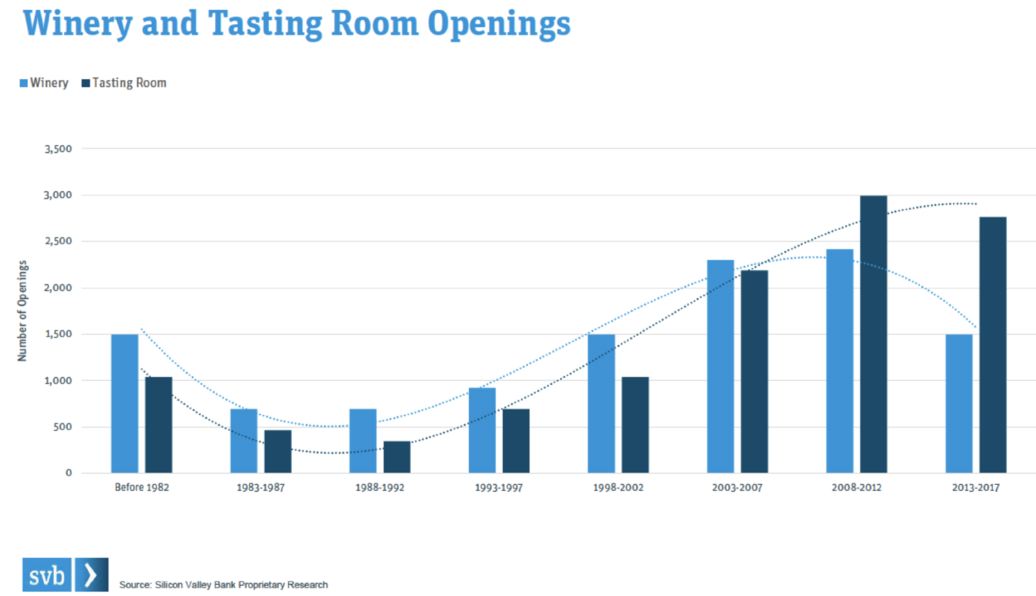
Alma Fria (Holtermann Family Wines), Sebastopol, CAAfter three generations in the wine import business. the Jan Holtermann found roots in the remote ridge tops of Annapolis on the West Sonoma Coast, committed to producing premium Pinot Noir and Chardonnay.Alma Fria means “the soul of the family” and/or “the cold of a geography.” The wines are sold primarily through a mailing list at www.almafria.com. Recently, Carroll Kemp, former owner and winemaker at Red Car, has joined Jan, his good friend, at Alma Fria as partner and winemaker.
2015 Alma Fria Plural Sonoma Coast Pinot Noir 13.2% alc., 300 cases, $40. Native fermentation, 10% whole cluster, aged 12 months in French oak barrels, 20% new. Bottled unfined and unfiltered. · Moderate garnet color in the glass. Hints of whole cluster are revealed in the nose that shows aromas of cherry, rose petal, spice and pipe smoke. The mid weight flavors of black cherry, black raspberry and tobacco are welcome and supported by filigree tannins, but the acid is out of balance in this wine. The vibrant finish is bitter and woody as well as tasting of pink grapefruit. Score: 87
2015 Alma Fria Doña Margarita Vineyard Sonoma Coast Pinot Noir 13.2% alc., 172 cases, $62. Vineyard planted in 2002 in Freestone at 500-625 feet elevation. 15% whole cluster, wild yeast fermentation, aged 12 months in French oak barrels, 30% new. · Moderately dark garnet color in the glass. Nice whole cluster imprint on the nose with aromas of dark cherry, exotic spices and pine sap. Slightly plush in the mouth in a mid weight plus style offering delicious flavors of black cherry, blueberry, cardamom spice and dried herbs. Adept harmony with fully integrated tannins and proper uplifting acidity on the juicy finish. I liked this wine. Score: 93
2015 Alma Fria Holtermann Vineyard Sonoma Coast Pinot Noir 13.4% alc., 95 cases, $62. Vineyard planted in Annapolis in 2002 at 700-800 feet elevation. 15% whole cluster, wild yeast fermentation, aged 12 months in French oak barrels, 25% new. · Moderate garnet color in the glass. Entirely different aromatic profile from Dona Margarita Vineyard, offering aromas of earthy flora, mushroom, nutty oak and purple and black fruits. A feral, savory wine that speaks of the earth and forest. Mid weight plus fruit flavors of black raspberry and blackberry framed by modest tannins, finish on a feral note. Score: 92
2015 Alma Fria Plural Sonoma Coast Chardonnay 13.4% alc., 180 cases, $40. Native yeast fermentation, aged 12 months in neutral French oak barrels. Bottled unfined and unfiltered. · Light golden yellow color in the glass. Lean citrus aromas along with more penetrating aromas of dried apple, pear and white flower blossom. Bright in the mouth with leaner, yet appealing flavors of green apple, pear and white grape. Excellent friendliness, with spirited acidity and a taut finish. An edgy wine that is stylish and sophisticated. Exceptional at this price point. Score: 93
2015 Alma Fria Campbell Ranch Vineyard Sonoma Coast Chardonnay 13.3% alc., 95 cases, $50. Vines planted in 2008 in Annapolis at 750 feet elevation. Wild yeast fermentation, aged in French oak barrels, 10% new. Native yeast fermentation, aged 12 months in French oak barrels, 20% new. Bottled unfined and unfiltered. · Light golden yellow color in the glass. Richly perfumed with aromas of lemon creme, pie crust and custard. Lighter and leaner in style with vivacious acidity, offering flavors of green apple, lemon-lime and a hint of tangerine and caramel. Only the slightest tannin in the background and a finish if grandeur that leaves persistent aromatic memories and quenching acidity. Score: 93
Asuncion Ridge Vineyards, Paso Robles, CAA producer of Pinot Noir from the Estate Asuncion Ridge Vineyard and Cabernet Sauvignon and Syrah from Paso Robles vineyards. The winery’s tasting room is in downtown Paso Robles at 725 12th Street on the City Park and is open daily. The success of the winery has led the owners, Philip Krumal and business partner to plant new vineyards and build a new winery with a tasting room. Three 5-star vineyard view house rentals are available through Asuncion Ridge. Visit www.asuncionridge.com.
2015 Asuncion Ridge Vineyards San Luis Obispo County Pinot Noir 14.4% alc., $45. Released May 2018. Estate vineyard is planted in the southern Santa Lucia Highlands mountains at 2000 feet elevation, a few miles inland from the Pacific Ocean. Winemaker Philip Krumal crafts his wines under the mentorship of winemaker Marc Goldberg and the inspiration of Yvonne Rich. · Moderately dark garnet color in the glass. The offers aromas of earth, potpourri, spice box and cigar smoke. Full bodied in the mouth, featuring generous flavors of black grape, black raspberry spiced with vanilla. Very agreeable, with a velvety texture, integrated tannins, appropriate oak input, and some finish. Reminds me of Meiomi Pinot Noir but better. Score: 90
2015 Asuncion Ridge Vineyards San Luis Obispo County Barrel Select Pinot Noir 14.7% alc., $65. Released May 2018. · Moderately dark garnet color in the glass. Shy dark fruit aromas along with oak spice and barrel notes. Very plush in the mouth in a mid weight plus style, with flavors of boysenberry and blackberry. The vanilla note found in the regular bottling shows up here as well. Big, ripe and boisterous, yet the tannins are restrained, the fruit is bright and not jammy, and oak adds agreeable highlights. A little more enjoyable when tasted the following day from a previously opened and re-corked bottle. Not my preferred style, but will find a good number of fans. Score: 92
Child’s Play (Tendril Wine Cellars), Gaston, ORThis is a value-priced play(sic) from proprietor and renowned Oregon winemaker Tony Rynders of Tendril Wine Cellars,.The labels feature artwork by his two daughters. The marketplace needs more reasonably priced wines made by experienced winemakers. So far, the project has not succeeded with Pinot Noir. I reviewed the 2014 WV Pinot Noir and scored it 86. Visit www.tendrilwines.com/wines/childs-play.
2015 Child’s Play Willamette Valley Pinot Noir 13.9% alc., 868 cases, $30, screw cap. Aged 10 months in primarily neutral French oak barrels. · Moderately dark garnet color in the glass. Off putting nose featuring aromas of charcoal and ash with fruit never showing up. Mid weighted, oak-infused, black cherry, black raspberry and plum flavors backed by dusty tannins. The oak treatment is imposing and the finish is astringent. Score: 84
2017 Child’s Play Willamette Valley Rosé of Pinot Noir 14.1% alc., 48 cases, $30, screw cap. Raised 6 months in stainless steel. · Moderate ruby red color in the glass. Nicely perfumed with aromas of dark red raspberry, spice box and rose petal. Bright, clean and seemingly dry, with flavors of red berry, cherry and savory herbs. A silky mouthfeel is enticing. This wine has had significant skin contact and is most like a Pinot Noir raised in neutral oak. Score: 89
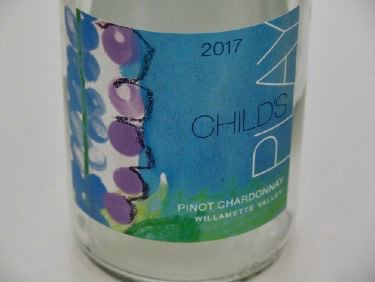 2017 Child’s Play Willamette Valley Pinot Chardonnay 13.5% alc., 175 cases, $30. screw cap. This is the most successful wine in the Child’s Play lineup. 70% Chardonnay and 30% “White” Pinot Noir, the only still blend of its kind in the US. Raised 6 months in stainless steel. · Light golden yellow color in the glass with the slightest pink tinge. The nose is unusual but very appealing, offering scents of woodsy cologne, warm brioche, white stone fruits and green apple. Refreshing in the mouth with a flavor profile similar to a Pinot Noir Blanc. Lighter in weight, with redeeming white peach, pear and nutty oak flavors in a nicely balanced, easy going style. Cool it down a bit and it will become an ideal summer wine. Skillfully composed. Score: 90
Emeritus Vineyards, SebastopolOver the years, I have tasted many Pinot Noir wines from Hallberg Ranch but I haven’t tried the wine that Emeritus produces from their estate vineyard. The winery dates to 1999 when Brice Cutrer Jones purchased Don and Marcia Hallberg’s prime 115-acre apple orchard in the heart of the Russian River Valley. Before that purchase, Jones had acquired a plot of land in Annapolis on the West Sonoma Coast, that was to become William Wesley Vineyard. A third vineyard, Pinot Hill, was acquired by Emeritus in 2008, and is located in Sebastopol Hills area of the Sonoma Coast. All vineyards are dry-farmed. A Pinot Noir is offered from each of these three estate vineyards. The current winemaker, David Lattin, brings 32 vintages of winemaking experience to his role at Emeritus. To purchase wines, visit www.emeritusvineyards.com.
2015 Emeritus Vineyards Hallberg Ranch Russian River Valley Pinot Noir 14.0% alc., $44. Soils here are Goldridge sandy loam. Multiple clones are planted over 107.76 acres, including 4, 5, 115, 459, 667, 777, “828,” Cruz, Elite and Hyde. · Moderately dark garnet color in the glass. This wine takes awhile to open and my comments are based on sampling the wine after the bottle had been opened several hours. Aromas of purple berries, spice and floral esters. An array of fruits great the palate including dark red cherry, raspberry and boysenberry arrayed in a mid weight style. Satiny in texture with modest tannins and bright acidity on the succulent yet uplifting finish. Great harmony at play here. Score: 93
[ess·eff] Wines, San Francisco, CAThis is a relatively new commercial winery based in San Francisco. Four friends (Jeremy Barry, Chip O’Connell, Ethan Smith and Tom Witczak) joined in 2012 to explore winemaking after living in The City. What started out as a side hobby, quickly became a business venture. The name of the winery is a phonetic play on the abbreviation of S.F. The current releases include a Russian River Valley Sauvignon Blanc, a Keller Estate Sonoma Coast Pinot Noir and a Teldeschi Vineyard Dry Creek Valley Zinfandel. The wines are produced a Dogpatch Wine Works, a custom crush facility in San Francisco. Visit www.esseffwines.com for availability.
2016 ess·eff Keller Estate Sonoma Coast Pinot Noir 14.7% alc., pH 3.60, TA 0.53, 24 cases, $42. Clones 123 and 777 co-fermented.Harvest Brix 24.5º. 100% whole berry. 2-day cold soak, aged 9 months in French oak barrels. · Moderate garnet color in the glass. Aromas of black cherry, spice, turned earth and slightly herbal. Light to mid weight flavors of black cherry and blueberry-pomegranate that are giving upon opening. This wine has good intentions, with balanced tannins, folded-in alcohol and a crisp finish that showed a little astringency initially but resolved when tasted the following day. The nose was more spirited the following day as well. Score: 90
Frank Family Vineyards, Calistoga, CAThe Frank Family Estate Lewis Vineyard is located in the heart of Napa-Carneros, near the shores of San Pablo Bay. The Lewis Vineyard was purchased by Rich Frank in 2000 and is named for Paul Frank’s son Lewis. The site consists of 86 acres, with 59 acres planted to Chardonnay and 10 acres to Pinot Noir. There is considerable maritime influence that makes the region ideal for cool climate varieties. The winemaker for this popular winery is Todd Graff. I have reviewed many wines from this winery over the years and they have been consistently excellent in their vivacious style. Visit www.frankfamilyvineyards.com.
2016 Frank Family Vineyards Lewis Vineyard Napa Valley Reserve Pinot Noir 14.5% alc., pH 3.64, TA 0.59, 1,000 cases, $65. Released March 2018. Heavy bottle with embossed label. Clones 115, 667 and 777. Aged 10 months in 50% new and 50% once-filled French oak barrels. · Moderately dark garnet color in the glass. Initially, the nose offers only toast and lite cigar aromas, but with swirling, ripe, black fruit aromas show up. Full-bodied, velvety and fat in the mouth with waves of blackberry and cassis fruit flavors. The oak is intrusive upon opening with flavors of vanilla and taste chiming in. The tannins are well-proportioned, the finish is not as intense as the fruit load would suggest and a bit of alcohol awareness peaks out at the end. The wine is accessible now but certainly should show less oak overlay with more time in bottle. Still, a lot of fruit and oak to get your arms around. Score: 89
2016 Frank Family Vineyards Lewis Vineyard Napa Carneros Reserve Chardonnay 14.5% alc., pH 3.53, TA 0.60, 1,000 cases, $65. Released March 2018. Heavy bottle with embossed label. Dijon clones. Aged 11 months in 100% new French oak barrels. · Moderately light golden yellow color in the glass. Lovely aromas of lemon curd, ripe yellow apple and crème brûlée. Creamy, and quite flavorful on the palate in a rich style popularized in California. Flavors of lemon, pineapple, tropical fruits and yellow grapefruit. Comforting to drink with a seductive mouth feel, but this is not particularly acid-driven wine as far as vibrancy or mineral content. The decadent fruit sops up the lavish oak such that the oak blends in and becomes complimentary. There are many fans who relish this style of Chardonnay. Score: 92
2016 Frank Family Vineyards Beckstoffer Lake Vineyard Reserve Napa Carneros Chardonnay 14.5% alc., pH 3.44, TA 0.60, 200 cases, Wine Club only. Released March 2018. Inaugural bottling. Heavy bottle with embossed label. Barrel fermented in 50% new and 60% once-filled French oak barrels for 9 months. Regular lees stirring to promote depth. · Moderately light golden yellow color in the glass. This wine has considerable “minerality” on the nose with aromas of riverbed, slate and lemon peel. Big and saucy for a Chardonnay, yet everything is kept in balance. The flavors of pear and apple and offer only subtle citrus notes. Creamy in the mouth from full malolactic fermentation. The wine’s bright acidity and firm structure holds the rich fruit in check. Stylistically, this wine is similar to the Lewis Vineyard Chardonnay, but but it is more in tune with my palate. Score: 94
Gary Farrell, Healdsburg, CA
2015 Gary Farrell McDonald Mountain Vineyard Russian River Valley Pinot Noir 14.1% alc., pH 3.26, TA 0.74, 585 cases, $65. Released May 2018.This vineyard is located in a souther cool area bordering the Petaluma Gap. Planted in 2008 to a diverse clonal selection including 115, 667, 777, Pommard, “828,” and Elite(?). 80% of grapes de-stemmed and 20% whole clusters added later. 5-day cold soak, 10-15 day extended maceration. Aged 16 months on the primary lees in French oak barrels, 40% new. · Moderately dark garnet color in the glass. Aromas of peppery dark fruits, exotic spices and toasty oak. A flood of purple berry and spice flavors greet the palate in a mid weight plush style flaunting an intense mid palate presence and a big, long finish. Soft in the mouth, with balanced tannins and righteous oak. More luscious and fruit-driven than usual for a Gary Farrell Pinot. Score: 93
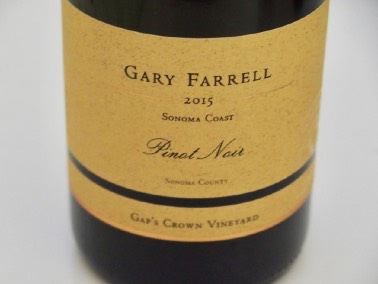 2015 Gary Farrell Gap’s Crown Vineyard Sonoma Coast Pinot Noir 14.3% alc., pH 3.37, TA 0.70, 494 cases, $75. Released May 2018. 106 acres of Pinot Noir first planted in 2002 in the new, cool Petaluma Gap AVA. Clones “828” and 667. 85% de-stemmed and 15% whole cluster added later. 5-day cold soak, 10-15 days of extended maceration, aged 16 months on the primary lees in French oak barrels, 40% new. · Moderately dark garnet color in the glass. Shy, but pleasant aromas of purple and black berry fruits plus fertile earth. A startling attack of boysenberry, black raspberry and dark strawberry fruit with a touch of spice in a mid weight plus style. Flat-out delicious, with amazing length in the mouth and a gracious, flavorful finish. The combination of boisterous fruit, enviable harmony, and polished mouthfeel makes for an invigorating experience. I recently wrote about this vineyard in the PinotFile as it has become one of California’s most provocative sources for Pinot Noir grapes. Score: 94
2015 Gary Farrell Bacigalupi Vineyard Russian River Valley Pinot Noir 14.1% alc., pH 3.37, TA 0.68, 591 cases, $65. Released May 2018. Release date May 2018. Sourced from Bacigalupi Frost Ranch and planted entirely to Wente selection. 85% de-stemmed, 15% of fruit added later as whole clusters. 6-day cold soak. 10-15 day extended maceration. Aged on the primary lees for 16 months in French oak barrels, 40% new. · Moderate garnet color in the glass. Demure aromas of dark red and blue berries with a bit of earthy flora. This wine is a little more acid driven and earthy and less fruity than the Gap’s and McDonald wines. Mid weight flavors of dusty dark red fruits uplifted with vibrant acidity, finishing long and cherry-driven. There is a curious thread of decaying matter in the background. Score: 92
2015 Gary Farrell Westside Farms Russian River Valley Chardonnay 13.9% alc., pH 3.12, TA 0.83, 631 cases, $55. Released May 2018. A 40-acre vineyard just four miles up Westside Road from the Gary Farrell Winery. The Chardonnay vines were planted in 1989 to clone 4. Harvest Brix 22º-23º. Gently whole cluster pressed, inoculated with Montrachet yeast, and aged 9 months in French oak barrels (both traditional barrels and 500-L puncheons), 35% new. Racked off primary lees only once, just before bottling. · Moderate golden yellow color in the glass. Terrific aromas of lemon curd, pineapple, buttery brioche, ripe melon, flint, caramel and nuts holds up in the glass over time. Richly fruited such that the wine has Russian River Valley written all over it, offering flavors of lemon, Golden Delicious apple, and pineapple. Slightly creamy on the palate, with an uptick of acidity on the refreshing finish that shows some length. A Caliesque style that often receives widespread embrace for its fruit, but different because of the energizing acidity that accompanies it in this wine. Score: 93
Joseph Jewell Wines, Cloverdale, CAFounders Micah Joseph Wirth and Adrian Jewell Manspeaker have been producing PInot Noir, Zinfandel and Chardonnay from vineyards in the Russian River Valley, Dry Creek Valley and Humboldt County. The business partners share the winemaking duties. They started very modestly, with just one ton of Russian River Valley Pinot Noir grapes, two French oak barrels and a small basket press. Currently, they produce 2500 cases annually. A tasting room is located in Forestville and the wines are produced in Cloverdale. For more information, visit www.josephjewell.com.
2014 Joseph Jewell Starscape Vineyard Russian River Valley Pinot Noir 14.2% alc., pH 3.56, TA 0.61, 200 cases, $N/A. Clones 777, “828,” and 115. Harvest Brix 24.2. 8% whole cluster, 12-day fermentation , aging for 11 months in French oak barrels, 33% new. Bottled unfined and unfiltered. · Moderately dark garnet color in the glass. Nice floral, pine forest and spiced cherry perfume. Luxurious and polished in the mouth, featuring a mid weight core of black cherry, and purple and black berry fruits. Admirable balance with only a hint of oak, finishing modestly. Charming upon opening but lost appeal when re-tasted the following day from a previously opened and re-corked bottle. Score: 90
2014 Joseph Jewell Starscape Vineyard Martini Clone - Old Girls Russian River Valley Pinot Noir 14.2% alc., pH 3.51, TA 0.59, 75 cases, $65, white wax topper. Grapes were sourced from some of the oldest Pinot Noir vines in Sonoma, first taking root in 1971. Yield 1 ton/acre. 100% de-stemmed, fermented 7-14 days in stainless open-top tanks. Aged 18 months in French oak barrels, 33% new. Bottled unfined and unfiltered. · Moderately dark garnet color in the glass. The aromatic profile is very similar to the regular Starscape bottling in this vintage but more sexy. Aromas of black cherry, underbrush, pine and floral bouquet. Noticeably more attacking on entry with a definite mid palate impression of dark cherry and boysenberry fruits, finishing with good persistence. Well-structured with very fine-grain tannins contributing to a polished mouthfeel. The fruit is quite ripe and the slightest alcoholic heat shows up in the glass over time as the wine warms in the glass. When tasted the following day from a previously opened and re-corked bottle, there was some volatile acidity (apple core aroma) on the nose but the wine still tasted fine. This wine has many good traits but there are a few nits. Score: 90
2015 Joseph Jewell Ryan Vineyard Humboldt County Pinot Noir 13.5% alc., pH 3.54, TA 0.62, 100 cases, $39. Clones 115 (80%), 777 (10%) and 667 (10%). Harvest Brix 23.5º. 100% de-stemmed, fermented 15 days in stainless open-top tanks. Aged 10 months in French oak barrels, 33% new. Bottled unfined and unfiltered. · Moderately dark garnet color in the glass. Leading off are aromas of purple grape and berry, baking spice and wood pile. Very pleasant in the mouth in a light to mid weight style, featuring vibrant flavors of black cherry and black raspberry. Simple, but soothing and very like able, although the wine had lost some appeal when retasted the following day from a previously opened and re-corked bottle (nose more vegetative and earthy and less flavorful). Should be drunk chilled on release. Score: 89
2015 Joseph Jewell Elk Prairie Vineyard Humboldt County Pinot Noir 14.2% alc., pH 3.59, TA 0.58, 75 cases, $42. Organically farmed Martini clone planted own-rooted in 1991. Harvest Brix 24.2º. 100% destemmed, native yeast fermentation in stainless open-top tanks. Aged 11 months in French oak barrels, 33% new. Bottled unfined and unfiltered. · Moderately dark garnet color in the glass. The nose starts out quite vegetative with aromas of turned earth and peat that give way over time to black cherry, berry jam and oak spice aromas. The mid weight flavors of dark red berries and cherries are accompanied by green tobacco and earth notes. The fruit tries hard to impress on the mid palate, but gives way on the short finish. Green tobacco and earth notes lean heavily on the fruit expression, and there is a bit of alcoholic heat on the finish. Score: 88
2015 Joseph Jewell Bucher Vineyard Russian River Valley Pinot Noir 13.4% alc., pH 3.59, TA 0.57, 100 cases, $50. Swan and Pommard clones. 100% de-stemmed, 10-day fermentation in stainless open-top tanks. Aged 11 months in French oak barrels, 25% new. Bottled unfined and unfiltered. · Moderate garnet color in the glass. Accessible nose offering aromas of floral cologne, black cherry, spice, and earthy flora. The light to mid weight core of red cherry fruit is underlain with a fecal/barnyard/tobacco/herbaceous thread that is typical of wines from this vineyard. The wine is nicely balanced, sleek in the mouth, with a juicy finish of modest length. The savory aspect of this wine is welcomed by many or may not appeal to drinkers like me. Score: 89
2017 Joseph Jewell Ryan Vineyard Humboldt County Rosé of Pinot Noir 12.9% alc., pH 3.22, TA 0.68, 370 cases, $24. Clone 115 organically farmed. 31 days whole cluster pressed, fermented in stainless tank. · Pretty pink salmon color in the glass. Gorgeous aromas of strawberry, orange zest and peach that soar over time in the glass. Plenty of expressive flavor with orange, yellow peach and guava fruits melded with the slightest dry tannins and a bolt of active acidity. A remarkably good and thoroughly dry rosé that is the perfect summer wine. Score: 92
La Crema, Santa Rosa, CAOne of California’s most reliable and consistent producers of Pinot Noir and Chardonnay.The wines are widely distributed and represent excellent values. This family-owned winery has been in business for more than 35 years and has spawned many notable winemakers who went on to found their own wineries. GRapes are now sourced from cool-climate appellations, from the Russian River Valley south to Monterey in California and the Willamette Valley of Oregon. The current winemaker is Craig McAllister. Tasting rooms are now open daily at Saralee’s Vineyard in Windsor and just off the square in Healdsburg. For more information, visit www.lacrema.com.
2016 La Crema Sonoma Coast Pinot Noir 13.5% alc., pH 3.69, TA 0.54, <100,000 cases, $25, Diam closure. Sourced from multiple vineyards in the Sonoma Coast AVA.Clones 23, 37, 115, 667, 777, “828,” Pommard, Calera, Swan and Martini. 100% de-stemmed with 70% whole berries in tank. 3-day cold soak, fermented primarily in open-top tanks. Aged 9 months in 97% French oak barrels, 25% new. · Moderate garnet color in the glass. Reserved aromas of dark berries and barrel room. Rich and bold in a mid weight plus style, offering an array of purple and black fruit flavors. Oak contributes flavors of black licorice and toast. There is an assertive tannic backbone creating some astringency on the finish. Highly fruit-driven and one-dimensional, but still manages to offer some redemptive vibrancy. Certainly, no sense of place in this wine. Score: 88
2016 La Crema Monterey Pinot Noir 13.5% alc., pH 3.70, TA 0.52, >100,000 cases, $23, Diam closure. 3-day cold soak, no post-fermentation maceration. Aged 9 months in French oak barrels, 21% new. · Moderately light garnet color in the glass. Pleasing aromas of cherry, sandalwood and fertile earth. Forward-drinking style, offering satisfying flavors of black cherry, dark red raspberry and the slightest hint of oak. Soft tannins make for easy drinking and the modest finish is just good enough. Score: 89
2016 La Crema Russian River Valley Chardonnay 14.5% alc., pH 3.50, TA 0.58, 15, 138 cases, $30, Diam closure. Grapes sourced from ten vineyards spread across the Russian River Valley AVA and sub-AVA of Chalk Hill. Clones were 4, 76, 95, 96 and 809. Whole cluster pressed, barrel fermented, and aged for 9 months with lees stirring 1-2 times per month. · Moderately light golden yellow color in the glass. Aromas of lemon zest, white peach warm brioche and toast lead off. A riper, luscious style featuring flavors of lemon, pineapple and honey. Slightly creamy in the mouth in a lower acid-driven style that seduces with richness and ripeness. Oak is involved but is not overbearing. Score: 90
LICHEN Estate, Boonville, CAThe Lichen Estate Vineyard overlook Highway 128 from the 203-acre Lichen Estate in Anderson Valley. Prepared in 2007 and planted in 2008 on meter-by-meter spacing, the vineyard comprises 75% Pinot Noir and 25% Pinot Gris vines. The vineyard is farmed organically. Pinot Noir clones are Martini, Wädenwil, Pommard and 667 on three rootstocks. The wines seem to improve with each vintage. The winery website is www.lichenestate.com.
NV LICHEN Estate Solera Volume 5 Anderson Valley Pinot Noir 13.3% alc., $50. A multi-vintage blend, including vintages from 2011 to 2016. 75% 2016 and 25% a blend of the previous five vintages. A unique combination offering fresh fruit from the recent vintage and complexity from the extended barrel aging. · Moderate garnet color in the glass. Accessible aromas of cherry, raspberry, baking spice, savory herbs and sandalwood. Nicely composed with a tasty cherry core, a very suave texture, adequate structure, and some generous finishing purpose. Even better when tasted the following day from a previously opened and re-corked bottle. Score: 92
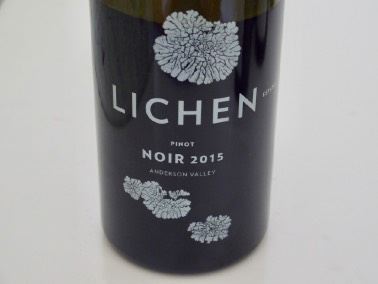 2015 LICHEN Estate Anderson Valley Pinot Noir 13.1% alc., pH 3.51, TA 0.56, 136 cases, $65. Released October 2017. 14 to 17-day fermentation in 500-liter oak puncheon after a 5 to 6-day cold soak. Aged 15 months in French oak barrels, Francoise Frères 3-year and 4- year dried, extra tight grain, medium plus toast, 25% new. Aged additional 8 months prior to bottling. · Moderately light garnet color in the glass. Enviable aromas of black cherry, fertile earth and underbrush. Imagine kicking dirt in a vineyard while chomping on a fresh cherry. Nothing but good things to say about this mid weight styled wine offering plenty of cherry and black raspberry goodness on the attack, mid palate and lengthy finish. Beautiful composure with adequate structure and expressive fruit. Even better when tasted the following day from a previously opened and re-corked bottle. Score: 93
2016 LICHEN Estate Moonglow Anderson Valley Pinot Noir 14.5% alc., pH 3.62, TA 0.55, 324 cases, $35. Released October 2017. 100% estate grapes. 1-4 day cold soak, fermented in closedtop fermenters and open-top bins. Native yeast fermentation. Aged in a majority of Francoise Frères 3-year and 4-year dried, extra tight grain, medium toast oak barrels.About 10% new barrels with remainder 10 to 40 months used. · Moderately dark garnet color in the glass. Very shy, but pleasant aromas of black cherry, pomegranate, bittersweet chocolate and toasted barrel. Mid weight plus in concentration featuring black cherry and blackberry fruit flavors framed by muscular tannins. Fruit-driven, with oak in the background. When tasted the following day from a previously opened and re-corked bottle, the tannins had resolved somewhat but the wine remained tannic. A young wine searching for its ultimate potential. Score: 90
Lingua Franca, Salem, ORBilled as “French Adventures in Oregon,” this winery was co-founded in 2015 by well-known sommelier Larry Stone, David Honig and Dominique Lafon. The exceptional vineyard site in the Eola-Amity Hills near Seven Springs Vineyard was bought by Larry in 2012. Brilliant French winemaker Thomas Savre, who had worked at some of the best domains in Burgundy was hired, with Dominique Lafon consulting. A spectacular winemaking facility has been built and tasting is now available by appointment. This is a winery to get to know. Attention to farming and winemaking detail is beyond reproach. The 2016 vintage represents the first release from the estate vineyard. The wines are sold primarily through a mailing list and wine club at www.linguafranca.wine.
2016 Lingua Franca AVNI Willamette Valley Pinot Noir 13.5% alc., $35. This wine represents the fruit flavor profile of the Eola-Amity Hills. Grapes sourced primarily from neighbors in Hopewell. · Moderate garnet color in the glass. Aromas brighten over time with air, revealing dark cherry, baking spices and turned earth. A bit forceful and tannic upon opening, becoming more seductive when tasted several hours after opening. Pretty mid weight black cherry and raspberry fruit flavors that hold on to the finish. Satisfying, with tannins that melt away in time, becoming more balanced and enriching. Score: 92
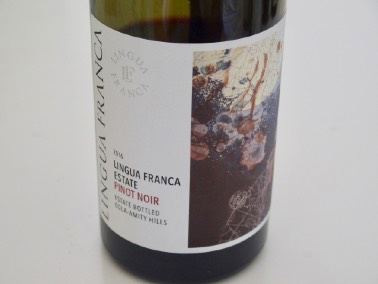 2016 Lingua Franca Estate Eola-Amity Hills Willamette Valley Pinot Noir 13.0% alc., $50. Inaugural release from the Estate Vineyard. Dry farmed organically on Basalt Jory and Nekia soils. Fruit is sorted in vineyard, then sorted by hand, and then sorted by a special de-stemmer/sorter. · Dark garnet color in the glass. The black cherry aromas are very slow to arrive in the glass. A bit brutish on the palate upon opening, but blossoming from a bottle opened several hours prior. A step up from the AVNI with more fruit intensity and more finishing length. Excellent pizazz with ideal tannin and acid integration and a suede texture. I absolutely loved this wine over time. Recommend decanting if you open now. Score: 94
2016 Lingua Franca Bunker Hill Vineyard Estate Willamette Valley Chardonnay 13.0% alc., $50. Vineyard planted in 1995 in stony volcanic soils in the Salem Hills. Clone 76 on pure Nekia soils at an altitude of about 800 feet. Vineyard is directly exposed to cooling ocean winds of the Van Duzer corridor. · Moderately light golden yellow color in the glass. Complex nose offering scents of lemon rind, sagebrush, buttercream, spice and men’s cologne. Riveting on the palate, with flavors of lemon, pineapple, slate, yellow grapefruit, and yellow peach flanked by spirited acidity. Finishes clean and tight with flinty acidity. Still special when an opened bottle was re-tasted the following day. Score: 94
Sarah’s Vineyard, Gilroy, CA
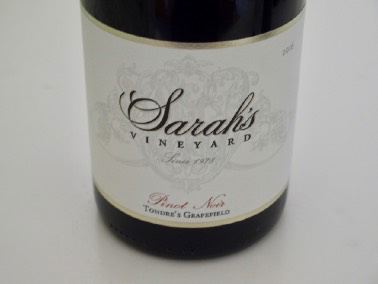 2016 Sarah’s Vineyard Tondre’s Grapefield Santa Lucia Highlands Pinot Noir 14.1% alc., 160 cases, $38. This vineyard is the prize of Sarah’s Vineyard and is capable of producing extraordinary Pinot Noir. Aged 11 months in French oak barrels, 25% new. Fantastic quality at a reasonable price. · Moderately light ruby red color in the glass. Clinging aroma of an array of red berries and a perfect compliment of oak. Somewhat light in color and lighter in weight and elegantly composed, but highly flavorful offering vibrant flavors of cherry and raspberry. Very charming and caressing in the mouth with a lacy texture and an appealing compliment of oak. This is a high fashion Pinot Noir that exemplifies what Pinot Noir should be - does not taste extracted or manipulated. Still delightful the following day. I have had many great wines from this vineyard. Score: 94
Sonoma-Loeb, (Chappellet Vineyard), St. Helena, CAAmbassador John Loeb Jr. sold his winery to Chappellet Vineyards in 2011. Sonoma-Loeb wines were already being produced at the Chappellet winery by winemaker Phillip Corallo-Titus. The Sonoma-Loeb wines have a depth and richness that they are known for, but Phillip has energized the Chardonnay wines in particular with more acidity, and has used less lees stirring and malolactic fermentation. As far as the Pinot Noir wines, they are stuffed with ripe fruit and fat in the mouth. This is not my preferred style of Pinot Noir but the wines are well crafted in this style. Visit www.sonomaloeb.com.
2016 Sonoma-Loeb Apple Lane Russian River Valley Pinot Noir 14.5% alc., pH 3.77, TA 0.58, $60. Inaugural release from this site. Vineyard has a marine climate, Goldridge sandy loam soils. Harvest Brix 27.0º. Clones 667, 777 and 115. Aged 11 months in French oak barrels, 40% new. · Dark garnet color in the glass. Soaring aromas of dark berries, cassis, baking spices and seasoned oak. Husky in the mouth, yet silky, blessed with a mid weight plus core of blackberry, cassis and boysenberry fruit flavors. Subtle oak in the background with polished tannins and enough acidity to temper the fruit load. A wine for fruit hedonists that finishes silky with generous sweet berry fruit. Score: 92
2016 Sonoma-Loeb Bateman Vineyard Russian River Valley Pinot Noir 14.5% alc., pH 3.70, TA 0.59, $60. Vineyard is located on Mill Station Road in Graton in the Green Valley of Russian River Valley AVA. Goldridge sandy loam soils. Harvest Brix 25.5º. Clones 777 and 115. · Dark garnet color in the glass. Aromas of fertile earth and black grape juice preview a mid weight plus styled wine with a core of purple and black berry fruit, a touch of spice and more noticeable oak. Well-structured, with a pleasing finish that reveals a slight sense of alcoholic heat. The wine improves over time in the glass. Score: 90
2016 Sonoma-Loeb Sangiacomo Vineyard Fedrick Ranch Sonoma Coast Pinot Noir 14.5% alc., pH 3.74, TA 0.59, $60. Vineyard is located on a bench land overlooking Petaluma River and San Pablo Bay. Harvest Brix 25.3º. Fermented with yeast strains from Burgundy and Germany, aged 11 months in French oak barrels. · Dark garnet color in the glass. Aromas of mushroom, wet log and blackberry. Mid weight essence of blueberrypomegranate juice with some toasty oak support. Silky in the mouth and lighter on its feet than the other two Sonoma-Loeb wines reviewed here, with some indulgent tannins and some length on the sweet-fruited finish. Score: 92
2016 Sonoma-Loeb Sonoma County Chardonnay 14.1% alc., pH 3.45, TA 0.61, $25. Harvest Brix 23.8º. Aged in French oak barrels. · Flashy aromas of butter, lemon, white peach and toast. Flavors of buttery fruits including lemon and pear. Slightly creamy in texture with noticeable toasty oak. Slight bitterness, but enough refreshing acidity. Doesn’t grab your attention. Score: 88
2016 Sonoma-Loeb Private Reserve Carneros Chardonnay 14.1% alc., pH 3.44, TA o.63, $27. Harvest Brix 23.8º. Sourced from several of Sangiacomo’s best blocks as well as grapes from other exceptional Carneros vineyards. Emphasis on Wente, Robert Young and Catrina clone Chardonnay. Barrel fermented and aged on the lees for 8 months with partial malolactic fermentation. · Modest, but pleasing aromas of apple, pear, yeast and seaweed. Excellent brightness in the mouth, with engaging flavors of lemon, dried apple, pear, and herbs. Sophisticated, with a good acid underbelly, no oak intrusion, and noticeable finishing length. Score: 91
Ten Acre Winery (Bella Vineyards & Wine Caves), Santa Rosa, CAThis is an upcoming winery to keep your eye on. Founded in 2008, by Lynn and Scott Adams, who have two decades of winegrowing experience in Sonoma County, they have gathered an impressive team that includes Vineyard Manager Charlie Chenoweth and acclaimed Winemaker Michael Zardo (formerly of Pisoni Vineyards). Tasting is available daily at Bella Vineyards in Healdsburg. Winery and cave tours are available by appointment with a two-week advance notice. Visit www.tenacrewinery.com. In the 2015 vintage, Ten Acre Winery also released a Ritchie Vineyard Chardonnay. This was such a spectacular wine that I will devote an entire feature to it in the next issue.
2015 Ten Acre Jenkins Vineyard Russian River Valley Pinot Noir 14.1% alc., pH 3.60, TA 0.65, 150 cases, $65. Vineyard planted by Charlie Chenoweth in 2001. Clones 115 and 667 planted in Goldridge gravelly loam soils. 5-day cold soak, native yeast fermentation. Aged in French oak barrels, 40% new. · Moderately light garnet color in the glass. Deep Bing cherry perfume along with a compliment of oak and spice rub. Black cherry and blackberry goodness floods the mouth in a mid weight styled wine with a rounded, soft texture. A brotherly touch of oak and friendly tannins are in harmony with the well-endowed fruit. Elegantly aggressive and quintessential Russian River Valley. Score: 94
2015 Ten Acre Soberanes Vineyard Santa Lucia Highlands Pinot Noir 14.6% alc., pH 3.60, TA 0.64, 100 cases, $65. Winermaker Michael Zardo first made a Soberanes vineyard-designate Pinot Noir while working as an assistant winemaker at Pisoni Vineyards. The vineyard is ideally located with exposure to Salinas Valley fog and wind, Soils are well-draining sandy loam and rocky decomposed granite. Pisoni clone planted in 2009. Yield 1.5 tons per acre. Aged 11 months in Taransaud French oak barrels, 25% new. · Moderately light garnet color in the glass. Leading off are aromas of black cherry, underbrush and oak char. Intensely flavored and succulent, in a mid weight plus style featuring flavors of black cherry and blueberry-pomegranate. A silky texture is seductive, the tannins are well matched and the toothsome fruit drives the finish. Tobacco oak plies the background and there is the slightest hint of alcohol on the finish. Score: 91
The Potter’s Vineyard & Vino Vasai Vintners, Newberg, ORSome readers will remember that this vineyard was previously owned by Laura Volkman. Winemakers Bill and Sandy Sanchez acquired the property from Laura in 2012 and have established their own identity and stamp on the wines produced from this vineyard. The name of the wines, “Vino Vasai,” translates to “Potter’s Wine” in Italian and reflects the Sanchez’s interest in handcrafted clay art that they display for sale in their tasting room. Visit www.pottersvineyard.com.
2015 Vino Vasai Dario Potter’s Vineyard Estate Chehalem Mountains Willamette Valley Pinot Noir 13.4% alc., 275 cases, $28. 3-acre vineyard planted in 2001 in Laurelwood and Jory soils. Dijon 114, 115 and 777. Harvest Brix 23.0º. Aged 11 months on the lees with stirring in French oak barrels, 35% new. Free run and press wine. · Moderate garnet color in the glass. Black cherry and dark rose petal aromas frame the nose. Juicy, with good fruit ripeness and purpose, featuring dark red cherry and blueberry flavors. Structured, but with tempered tannins, no oak intrusion, and some finishing length. More expressive when tasted from a previously opened and re-corked bottle two days later. Score: 91
13.4% alc., 98 cases, $38. A selection of the best neutral barrels. Aged 11 months on the lees with stirring in neutral French oak barrels. Free run and press wine. · Moderate garnet color in the glass. Aromas of cherry, peppery spices and green growth. Very similar to the Estate bottling but with less aromatic appeal, but a more heavenly satin texture. Middleweight in concentration featuring black cherry and raspberry fruit flavors that show some persistence on the finish. A fine unoaked wine that wants for a little more complexity. Score: 90
2015 Vino Vasai Potter’s Vineyard Estate Reserve Chehalem Mountains Willamette Valley Pinot Noir 13.5% alc., 98 cases, $50. Primarily Pommard clones. Harvest Brix 23.5º. Aged 11 months on the lees with stirring in French oak barrels, 75% new. · Moderate garnet color in the glass. Oak plays more of a role in the nose and tannin structure of this wine. Black cherry is the theme as is usually the case with Pommard clone, with the perfectly ripened fruit showing good attack, mid palate presence and finishing generosity. There is a very healthy tannic backbone that leads to mild astringency on the finish. This wine showed better integration of tannins when tasted the following day from a previously opened and re-corked bottle, indicating some cellaring is advised. Score: 92
Waits-Mast Family Cellars, San Francisco, CA
2015 Waits-Mast Mendocino County Pinot Noir 13.3% alc., 75 cases, $35. Released November 2017. A select blend of different barrels from the winery’s vineyard-designate wines: Mariah Vineyard in the Mendocino Ridge and Oppenlander Vineyard in Mendocino County. Harvest Brix 23.9º (Mariah) and 26.5º (Oppenlander). 100% de-stemmed, native yeast (Oppenlander) and proprietary yeast (Mariah). Aged 16 months in neutral French oak barrels and bottled unfined and unfiltered. · Moderately light garnet color in the glass. Aromas of cherry and sandalwood lead to a lighter weighted wine featuring cherry and blueberry fruit flavors that are simple but satisfying. Sleek in the mouth with good t n’ a balance and some red cherry finish. A very good daily drinker. Score: 89
2015 Waits-Mast Deer Meadows Vineyard Anderson Valley Pinot Noir 13.2% alc., 70 cases, $58. Released March 2018. Vineyard is situated at 1600 feet elevation above Boonville. Owned and farmed by Rich Savoy. Harvest Brix 22.8º and 23.4º. Clones 115, 777 and Calera. 100% de-stemmed, native fermentation, aged 16 months in French oak barrels, 33% new. Bottled unfined and unfiltered. · Moderate garnet color in the glass. Bright aromas of black cherry, fertile earth and friendly oak. Mid weight flavors of red cherry and berry and blueberry with a savory herbal thread. Silken tannins, with deft oak management. A solid wine but doesn’t overly excite. Score: 90
 2015 Waits-Mast Nash Mill Vineyard Anderson Valley Pinot Noir 13.2% alc., 70 cases, $42. Released November 2017. Average harvest Brix 23.5º. Clones 115, 667 and Pommard. 100% de-stemmed, proprietary yeast fermentation. Aged 16 months in French oak barrels, 33% new, and bottled unfined and unfiltered. · Moderately light garnet color in the glass. Lovable aromas of red berries, fresh cherry, spice and sandalwood. Discretely concentrated essence of cherry and raspberry with impressive length in the mouth and on the finish.Luxurious mouthfeel, with very fine-grain tannins and a compliment of toasty oak in the background. This is clearly a special vineyard. Score: 93
Pinot BriefsBless Your Hearts Burgers at Atticus Expands Menu McMinnville’s Atticus Hotel is expanding their menu offerings based on customer feedback. A new Happy Hour Menu has been added with dishes like nachos, hush puppies and Carolina Cheesesteak and Pretty Damn Good Chicken Strips. The burger menu salad offerings have been updated as well. The dessert menu now offers milkshakes, hot fudge sundae and “Death by Chocolate” ice cream cones. The cocktail menu has been completely revamped as well and local Willamette Valley wines are on cask. Brunch available daily from 8 am to 12 pm has new additions as well.
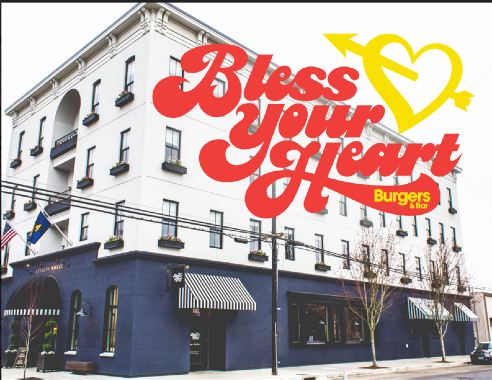 Mark Tarlov Releases First Single Origin Wines The Rose & Arrow Estate at Chapter 24 is the consummation of a five-year investigation into the natural causes that produce the drinking experiences we love. Harvesting multiple lots up and down the Willamette Valley, we discovered that the wines we love begin on articulated ribbons of eroded volcanic rock. This is our place where the vines carry the character of the hill in its most primitive, liberated, detailed and delicious form.” Pinot Noir has been released from seven Oregon places. Early reports from the wine press heap lavish claims about these wines. The wines also push into triple digit pricing, with prices varying from $100 to $120 to $150 a bottle. Pinot in The City Denver 50 wineries from Oregon’s Willamette Valley will be showcasing Pinot Noir, Chardonnay, Pinot Blanc, Pinot Gris and sparkling wines on Tuesday, August 21. Owners and winemakers will be pouring a selection of wines including library and current releases, paired with Pinot Noir-friendly small bites. For tickets, visit www.willamettewines.com/pinot-in-the-city-denver/.
 A Reader Responds Al Prince (no relation), told me in an email, “After seeing your review about the 2015 Calera Jensen Pinot Noir, I dropped by the winery this week on my way back from Monterey to the Bay Area. After opening one bottle tonight we decided to try the wine tomorrow night in order to give it more time to open up. That being said, this wine, at first blush, is just incredible. I was mesmerized by just the first taste, and I am doing everything I can to hold off having a second taste until tomorrow. Thanks for continuing to do the hard work for all of us out here in the hinterlands. I don’t know how you do it.” Alma de Cattleya Wines has New Website The Alma de Cattleya wines, crafted by Bibiana González Rave, include Sauvignon Blanc, Rosé, Chardonnay and Pinot Noir. The project was based on her desire to craft a wine that she could export to here native Columbia, at a reasonable price for everyday drinking. Visit the new website at www.AdCWines.com. The wines are sold on the website, through a mailing list and through wine retailers.
 New Book: The Sommelier’s Atlas of Taste Raj Parr and co-author Jordan MacKay set out to answer the question, “Why do the great wines of the old world taste the way they do?” Raj asked the great winemakers of Europe all the questions necessary to understand their wine, the land and their traditions. Preorders are being taken for signed copies that will ship 11/5/2018.
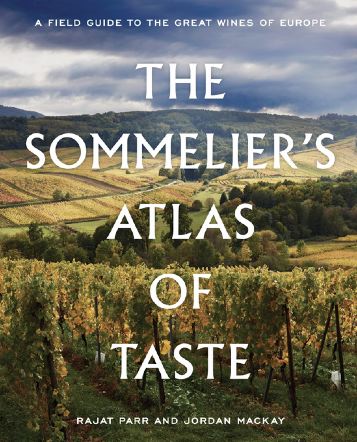 Zazu Food Truck Back at Davis Family Tasting Room For Summer The Zazu Food Truck is back on Saturdays and Sundays beginning June 16 and 17. Zazu will be serving up gourmet food at the tasting room and garden next to the Russian River Valley. Buy a bottle of one of Davis Family Vineyards award-winning wines, take it out on the deck with a beautiful view and feast on a Zazu Black Piglet BLT. 52 Front St. in Healdsburg. Astro Motel Offers Adventure Package The 34-room Astro Motel is a stylish remodel of a 1963 motor lodge located in Santa Rosa, CA. The Astro is urban, affordable and furnished with original midcentury modern pieces acquired at nationwide auctions. Book until June 30 for 1 queen accommodation, 2 bike rentals with a map to one of the many Santa Rosa parks of your choice, and a picnic prepared by The Spinster Sisters Restaurant (whose owner, chef Liza Hinman, also heads the team that owns the Astro Motel) located nearby. $179 a night Sunday-Thursday. Visit www.TheAstro.com. The Spinster Sisters is currently my favorite restaurant in Santa Rosa. Results of 2019 Pinot Noir Masters This year’s competition again highlighted the quality of Pinot Noir from the US and New Zealand. Some wines swung towards two extremes - either too light and green, or too rich and alcoholic. Top Pinot Noir wines from the US were from Domaine Serene, Penner-Ash, and Gran Moraine. Copain and Hahn performed well in their less expensive category. Pinot Noir #3 among Top 10 Wine grapes in the United States Per and Britt Karlsson compiled a listing of the top 10 most popular wine grapes in the United States: https://www.forbes.com/sites/karlsson/2018/06/08/the-most-popular-wine-grapes-in-the-us-chardonnay-andcabernet- the-full-top-10-list/#132913bdfbfb. Discarding non-wine-making grape varieties such as Sultanina and Concord, there is roughly 800,000 acres of vineyards for wine production in the United States. The most planted variety is Chardonnay with 106,000 acres. Cabernet Sauvignon is in second place with 101,300 acres. The spectacular growth of Pinot Noir puts it in third place with 61,800 acres. Pinot Noir is the #2 red grape in California behind Cabernet Sauvignon with 45,300 acres planted, and is the #1 red grape in Oregon, with 18,300 acres planted. Alcohol Sales at Grocery Stores Exceeds All Other Foods in Growth From 2011 to 2016 USD sales growth by grocery department showed a clear advantage for alcohol sales with a 25.3% increase. The grocery industry has not paid enough attention to this and could do even more to promote alcohol sales. Santa Monica Garagiste Wine Festival This is becoming a popular event since it presents the wines of small, boutique wineries. A majority of the participating wineries do not have tasting rooms and are trying to find an audience. The next Garagiste Wine Festival will feature over 45 wineries on July 21, 2018, in Santa Monica, CA. Participating wineries reviewed in the PinotFile include Cutruzzola Vineyards and Kitson. This is not a Pinot Noir festival but offers wines of all kinds. Tickets available now: visit www.garagistevestival.com.
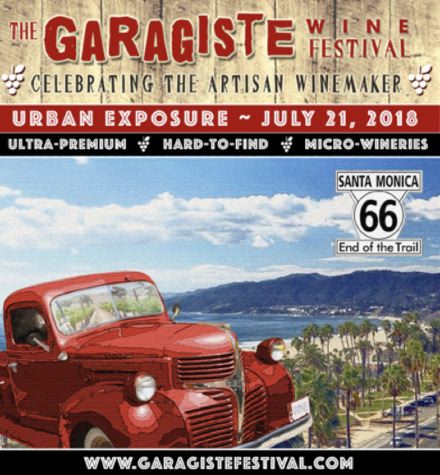 NW Wine Shuttle This company offers ecoShuttles fueled with biodiesel. The company’s first route features the Dundee Hills. Guests visit the website to design their own wine experience, choosing from a list of wineries they wish to visit. If their minds change when in route, guests can hop off wherever they’d like. For information and fees, visit www.nwwineshuttle.com. Five New sub AVAs Proposed by Willamette Valley Winegrowers As if it is not confusing enough for the consumer, with six sub AVAs in the Willamette Valley AVA, five more sub AVAs are currently being reviewed by the TTB. The new proposed sub AVAs include Tualatin Hills, Laurelwood, Van Duzer Corridor, Mount Pisgau, Polk County and Lower Long Tom. An AVA on an Oregon label ensures that at least 85 per cent of its grapes were grown in the specific AVA and this is said to build consumer confidence. The division among areas of the Willamette Valley is creating a confusing system like Burgundy’s village system that few people truly understand. Honestly, in talking with numerous consumers apart from Pinot aficionados, most refer to Oregon as the source of a wine and maybe Willamette Valley, but very, very few can spout off the names of the six current sub AVAs in the Willamette Valley and understand the differences among them. My extensive experience tasting Oregon Pinot Noir does allow me to appreciate the current six AVA differences, but I am often fooled when wines from various sub AVAs are tasted blind. Oregon Wine History A new website at www.oregonwinehistory.com has been developed by Herb Sims, a winegrower and winery co-owner that documents the history of the Oregon wine industry. There is a well-researched and exhaustive listing of pioneering vineyards and wineries. Domaine Serene Reaches Out to Portland Domaine Serene seems to be in the news constantly and the latest is the opening of a wine lounge inside downtown Portland’s Sentinel Hotel. The tasting room opened in April and offers rare wines by the glass and bottles for drinking in the wine lounge or off premises. Summer Oregon Wine EventsTenth Annual Forest Grove Uncorked! will be held August 18, 2018 on Main Street in Forest Grove. Wine, spirits, microbrews and food experience. Tickets at www.fguncorked.com. The Oregon Croquet Classic, presented by Classic Wines Auction, will be held at the Stoller Family Estate in Dayton on Saturday, July 21, 2018. Wine tastings, lawn games, gourmet bbq and live entertainment. Benefits five nonprofits serving children and families. Tickets at www.oregoncroquetclassic.com. Small Bits Winemaker Jeff Hansen, founder of Anderson Valley’s Lula Cellars passed away · Ian Burch is the new winemaker at Archery Summit in Oregon. He began his career in Oregon at Evening Land Vineyards and most recently Scott Paul Wines · The Donum Estate in Sonoma Carneros now boasts over 35 works of art on display, including works by renowned artists such as Ai Weiwei and Keith Haring. The Donum Estate has incorporated some of the art into their labels · Cuvaison is approaching its 50th anniversary and created a new brand platform, visual identity, packaging and website. 2018 IPNC Last Call The 2018 International Pinot Noir Celebration (IPNC) will be held July 27-29 at Linfield College in McMinnville, Oregon. This 3-day event is considered the best Pinot Noir Festival in the US, and an absolute must for Pinot Noir lovers. I have attended multiple IPNCs and thoroughly enjoyed myself each time. Limited tickets are still available at www.ipnc.org. Check the website for a full listing of participating wineries, including LUMOS Wine Company and Coelho Winery, whose wines were highly recommended in this year’s PinotFile.
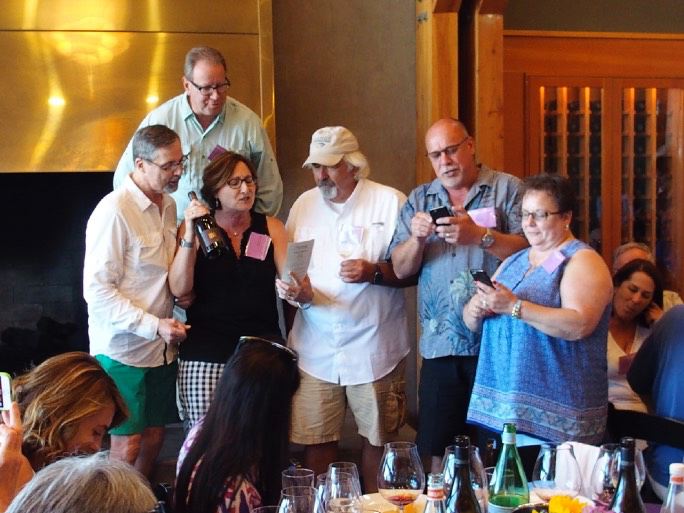
|